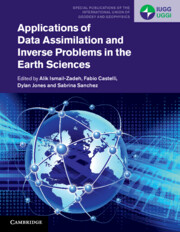Book contents
- Applications of Data Assimilation and Inverse Problems in the Earth Sciences
- Series page
- Applications of Data Assimilation and Inverse Problems in the Earth Sciences
- Copyright page
- Contents
- Contributors
- Preface
- Acknowledgements
- Part I Introduction
- 1 Inverse Problems and Data Assimilation in Earth Sciences
- 2 Emerging Directions in Geophysical Inversion
- 3 A Tutorial on Bayesian Data Assimilation
- 4 Third-Order Sensitivity Analysis, Uncertainty Quantification, Data Assimilation, Forward and Inverse Predictive Modelling for Large-Scale Systems
- Part II ‘Fluid’ Earth Applications: From the Surface to the Space
- Part III ‘Solid’ Earth Applications: From the Surface to the Core
- Index
- References
4 - Third-Order Sensitivity Analysis, Uncertainty Quantification, Data Assimilation, Forward and Inverse Predictive Modelling for Large-Scale Systems
from Part I - Introduction
Published online by Cambridge University Press: 20 June 2023
- Applications of Data Assimilation and Inverse Problems in the Earth Sciences
- Series page
- Applications of Data Assimilation and Inverse Problems in the Earth Sciences
- Copyright page
- Contents
- Contributors
- Preface
- Acknowledgements
- Part I Introduction
- 1 Inverse Problems and Data Assimilation in Earth Sciences
- 2 Emerging Directions in Geophysical Inversion
- 3 A Tutorial on Bayesian Data Assimilation
- 4 Third-Order Sensitivity Analysis, Uncertainty Quantification, Data Assimilation, Forward and Inverse Predictive Modelling for Large-Scale Systems
- Part II ‘Fluid’ Earth Applications: From the Surface to the Space
- Part III ‘Solid’ Earth Applications: From the Surface to the Core
- Index
- References
Summary
Abstract: This chapter presents a third-order predictive modelling methodology which aims at obtaining best-estimate results with reduced uncertainties (acronym: 3rd-BERRU-PM) for applications to large-scale models comprising many parameters. The building blocks of the 3rd-BERRU-PM methodology include quantification of third-order moments of the response distribution in the parameter space using third-order adjoint sensitivity analysis (which overcomes the curse of dimensionality), assimilation of experimental data, model calibration, and posterior prediction of best-estimate model responses and parameters with reduced best-estimate variances/covariances for the predicted responses and parameters. Applications of these concepts to an inverse radiation transmission problem, to an oscillatory dynamical model, and to a large-scale computational model involving 21,976 uncertain parameters, respectively, are also presented, thus illustrating the actual computation and impacts of the first-, second-, and third-order response sensitivities to parameters on the expectation, variance, and skewness of the respective model responses.
Keywords
- Type
- Chapter
- Information
- Publisher: Cambridge University PressPrint publication year: 2023



